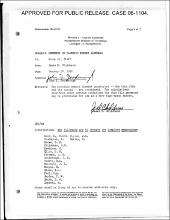| dc.contributor.author | Childress, James D. | en_US |
| dc.date.accessioned | 2009-06-15T19:38:01Z | |
| dc.date.available | 2009-06-15T19:38:01Z | |
| dc.date.issued | 1956-01-18 | en_US |
| dc.identifier | MC665_r15_M-4089 | en_US |
| dc.identifier.uri | http://hdl.handle.net/1721.3/40567 | |
| dc.description | Includes: introduction; theoretical ruminations; discussions and conclusions. | en_US |
| dc.description.abstract | Two possible memory element geometries — the thin film
and the toroid — are considered. The calculations
show that under certain conditions the thin film geometry may be preferable for use in a very high-speed memory. | en_US |
| dc.language.iso | en | en_US |
| dc.publisher | Lincoln Laboratory - Division 6 | en_US |
| dc.relation.ispartofseries | Division 6 Memo M-4089 | en_US |
| dc.relation.ispartofseries | Project Whirlwind Collection, MC665 | en_US |
| dc.subject.other | memory-plane drivers | en_US |
| dc.subject.other | magnetic memory elements | en_US |
| dc.subject.other | peak voltage | en_US |
| dc.subject.other | switch time | en_US |
| dc.subject.other | memory cycle | en_US |
| dc.subject.other | thin film | en_US |
| dc.subject.other | order of magnitude calculations | en_US |
| dc.title | Geometry of magnetic memory elements | en_US |
| dc.type | Technical Report | en_US |

